自動パッチクランプと高分子
自動パッチクランプ(APC)システムは20年に渡り低分子薬剤開発や特性評価に利用されてきた一方、高分子特性評価における利用では遅れをとっていました。
しかし、高分子および、そのAPCによる特性評価は創薬研究において、年々重要さを増しています。現在、承認済医薬品の90%以上は低分子によるものですが、高分子(>1 kDa、または生物製剤としても知られる)は創薬研究において急速にその重要性を増しており、世界の医薬品販売上位10品目の大部分を占めるに至っています。
高分子の分野
- ベノム、毒素、ペプチド(〜3-4 kDa、30-40のアミノ酸)
- Wntペプチド(〜35-45 kDa、350-400のアミノ酸)
- ノットボディーとナノボディー(〜50-60 kDa、400-500のアミノ酸)
- 抗体(〜150-170 kDa、〜1400のアミノ酸)
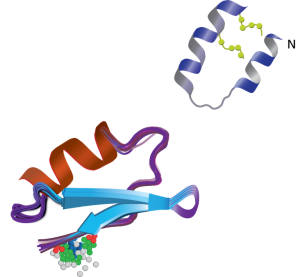
ベノム、毒素、ペプチド
生物や植物の毒素は、生理的な経路の重要な役割(例えば活動電位の開始と伝播)を妨害する強力なイオンチャネル調節物質として進化してきました。いくつかの毒素はとても強力であり、個々のイオンチャネルに特異的に作用します。これらはイオンチャネルの構造や機能を解明するための研究ツールとして広く利用されてきました。また、毒素は、新しい生理活性分子のペプチドフレームワークとして、あるいは薬物コンジュゲートの標的足場として、新規治療薬の開発にますます使用されるようになってきています。
自動パッチクランプを使ったベノムやペプチド特性評価への自動パッチクランプ利用に関心のある方は、QPatchを使用したクイーンズランド大学から発表されている多数の論文をご参照くだまた,また、Qube384を使ったベノム毒素ライブラリースクリーニングに関するSophionのウェビナーもご覧いただけます。
 主な関連論文のリストについては以下をご確認ください。また、さらに詳しい出版物の情報についてはこちらからご確認いただけます。
主な関連論文のリストについては以下をご確認ください。また、さらに詳しい出版物の情報についてはこちらからご確認いただけます。
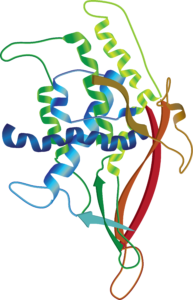
Wntペプチド
Wingless-related integration site (Wnt) は、350-400 アミノ酸長を持つ多様な分泌型シグナル伝達糖タンパク質ファミリーからなり、近距離でシグナル伝達を行う分子として働いています。Wntシグナルの活性化は、真核細胞において複雑な下流のシグナルカスケードを開始し、がんを含む多くの疾患の発生に重要な役割を果たしています。Wntペプチドは細胞内Ca2+を上昇させることによりK+電流を活性化し、細胞内貯蔵物からのCa2+放出を誘発します。Wntペプチドは遺伝子転写において重要な意義があり、この致命的な疾患の治癒の新たな道を開きます。
自動パッチクランプを使ったWnt特性評価について関心のある方は、SophionがKings College Londonと共に行った腫瘍学におけるイオンチャネルのオンラインセミナーをご視聴ください。また、Wnt peptides control mammalian cancer cell membrane potentialやWnts control membrane potential in mammalian cancer cellsの研究成果についてもご確認いただけます。
主な関連出版物のリストについては以下をご確認ください。または、さらに詳しい出版物の情報についてはこちらからご確認いただけます。
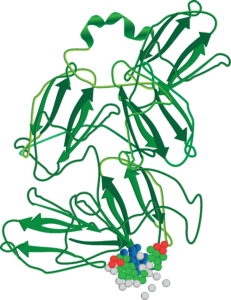
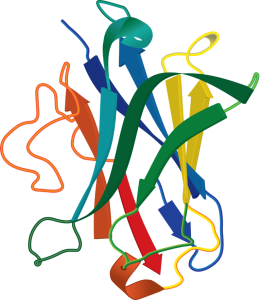
ノットボディーとナノボディー
結節ペプチドは構造的に多様な生理活性分子を豊富に含んでいます。インヒビター・システィン・ノット(ICK)とノットチンクラスは生態学的に最も一般的なものの一つです。これら多くの自然由来製品は、絶妙な選択と効力で電位依存性イオンチャネルなどの細胞外ターゲットと相互作用し、興味深い治療法を実現します。
ノットボディーとナノボディーにおける自動パッチクランプの利用について関心のある方は、IONTASからの研究成果Generating ion channel blocking antibodies by fusing knottin to peripheral CDR loops及びGenerating potent and selective inhibitors of Kv1.3 ion channels by fusing venom derived mini proteins into peripheral CDR loops of antibodiesをご覧ください。
主な関連出版物のリストについては以下をご確認ください。または、さらに詳しい出版物の情報についてはこちらからご確認いただけます。
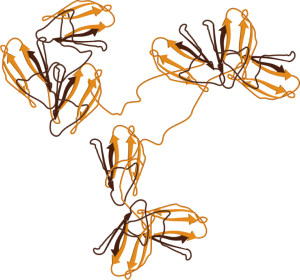
抗体
抗体はターゲット抗原に対し高い特異性、選択性や親和性を示すため、イオンチャネルを高精度に標的にできる可能性があります。しかし、イオンチャネルに対する抗体を分離することは困難です。これはイオンチャネルを抗体医薬の探索に適した形式で発現・精製することが困難であることや、機能探索のためのスクリーニングが複雑であることに起因しています。
自動パッチクランプを使った抗体特性評価について関心のある方は、ぜひSophionにご連絡ください。正確な研究成果や成功率を上げるためのヒントやコツに関する情報をご提供します。
In vitro discovery and optimization of a human monoclonal antibody that neutralizes neurotoxicity and lethality of cobra snake venom, Modulation of P2X3 and P2X2/3 Receptors by Monoclonal AntibodiesやScreening Strategies for the Discovery of Ion Channel Monoclonal Antibodiesなどで出版物もご確認いただけます。
詳しい情報は当社にご連絡ください。
 主な関連出版物のリストについては以下をご確認ください。または、さらに詳しい出版物の情報についてはこちらからご確認いただけます。
主な関連出版物のリストについては以下をご確認ください。または、さらに詳しい出版物の情報についてはこちらからご確認いただけます。
APCと高分子に関する厳選資料
プレゼンテーション
- Webinar: APC and large molecules – A Venomtech/Charles River Laboratories venom toxin library screen
アプリケーションレポート
- High throughput electrophysiological screen of antibody-based antivenom on Qube 384
- Large molecules: Scorpion toxin block of BK channels on Qube 384
- Large molecules on QPatch: IgG antibodies against α-cobratoxin as novel antivenom
ポスター
- Automated Patch Clamp Evaluation of Snake Neurotoxins and Recombinant Antibody Antivenoms. Boddum, Ledsgaard, Busk, Bell and Laustsen. Poster. Gordon Research Conference, Lucca, Italy. 2022
- High throughput electrophysiological screen of large molecules: evaluating snake neurotoxins and the neutralization potential of recombinant antibodies. Boddum, Ledsgaard, Busk, Bell and Laustsen. Virtual Poster. Society for Neuroscience 2021
- Toxin pharmacology and MoA data against Nav 1.X channels: Multi-parameter analysis using Sophion Qube high-throughput automated patch clamp platform. Duncan, Williams & Kammonen (Charles River Laboratories). Poster. Society for Neuroscience 2021
- Wnt peptides control mammalian cancer cell membrane potential. Ashmore, Olsen, Sørensen, Thrasivoulou, Ahmed (Kings College London, University College London, Sophion Bioscience). Poster. 2019
主な出版物
– Find abstracts & links in our publication database
Aqwa et al., 2018 Efficient Enzymatic Ligation of Inhibitor Cystine Knot Spider Venom Peptides: Using Sortase A To Form Double-Knottins That Probe Voltage-Gated Sodium Channel NaV1.7.
Ashmore et al., 2019 Wnts control membrane potential in mammalian cancer cells.
Agwa et al., 2020 Manipulation of a spider peptide toxin alters its affinity for lipid bilayers and potency and selectivity for voltage-gated sodium channel subtype 1.7.
Chow et al., 2019 Venom Peptides with Dual Modulatory Activity on the Voltage-Gated Sodium Channel NaV1.1 Provide Novel Leads for Development of Antiepileptic Drugs.
Colley et al., 2018 Screening Strategies for the Discovery of Ion Channel Monoclonal Antibodies.
Deuis et al., 2017 Pharmacological characterisation of the highly Na v 1.7 selective spider venom peptide Pn3a.
Gonçalves et al., 2019 From identification to functional characterization of cyriotoxin-1a, an antinociceptive toxin from the spider Cyriopagopus schioedtei.
Gonçalves et al., 2018 Direct evidence for high affinity blockade of NaV1.6 channel subtype by huwentoxin-IV spider peptide, using multiscale functional approaches.
Inserra et al., 2017 Multiple sodium channel isoforms mediate the pathological effects of Pacific ciguatoxin-1.
Israel et al., 2018 The E15R Point Mutation in Scorpion Toxin Cn2 Uncouples Its Depressant and Excitatory Activities on Human NaV1.6.
Jin et al., 2015 δ-conotoxin SuVIA suggests an evolutionary link between ancestral predator defence and the origin of fish-hunting behaviour in carnivorous cone snails.
Klint et al., 2015 Rational engineering defines a molecular switch that is essential for activity of spider-venom peptides against the analgesics target NaV1.7.
Ledsgaard et al., 2021 In vitro discovery and optimization of a human monoclonal antibody that neutralizes neurotoxicity and lethality of cobra snake venom.
Petrou et al., 2017 Intracellular calcium mobilization in response to ion channel regulators via a calcium-induced calcium release mechanism.
Prashanth et al., 2017 Pharmacological screening technologies for venom peptide discovery.
Robinson et al., 2018 A comprehensive portrait of the venom of the giant red bull ant, Myrmecia gulosa, reveals a hyperdiverse hymenopteran toxin gene family.
Schwalen et al., 2021 Scalable Biosynthetic Production of Knotted Peptides Enables ADME and Thermodynamic Folding Studies.
Shcherbatko et al., 2016 Modulation of P2X3 and P2X2/3 receptors by monoclonal antibodies.
Shcherbatko et al., 2016 Engineering highly potent and selective microproteins against Nav1.7 sodium channel for treatment of pain. J Biol Chem. 2016;291(27):13974–86.
Sousa et al. 2017 Discovery and mode of action of a novel analgesic β-toxin from the African spider Ceratogyrus darlingi.
Tran et al., 2020 Enzymatic Ligation of a Pore Blocker Toxin and a Gating Modifier Toxin: Creating Double-Knotted Peptides with Improved Sodium Channel NaV1.7 Inhibition.
Yang et al., 2016 The snake with the scorpion’s sting: Novel three-finger toxin sodium channel activators from the venom of the long-glanded blue coral snake (calliophis bivirgatus).
